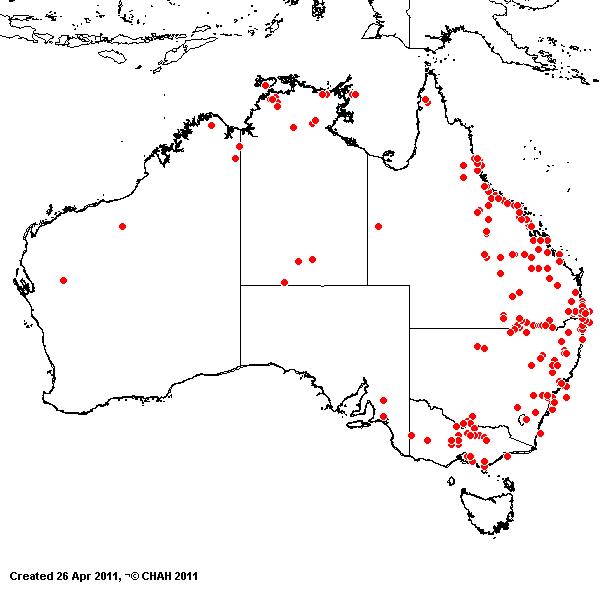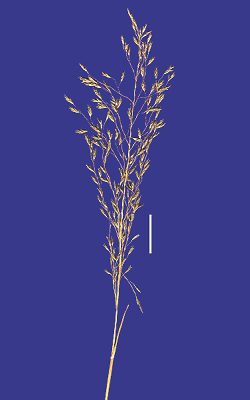Eragrostis pilosa* (L.) Beauv. Ess.
Agrost. 71, 162, 175 (1812).
Classification. (GPWG 2001) : Subfamily Chloridoideae. Cynodonteae.
Basionym and/or
Replacement Name: Poa pilosa L., Sp. Pl. 1.
68 (1753).
Type of Basionym or
Protologue Information: LT: Scheuzer, Agrostographia 193, pl. 4 4,
f. 3 (1719), LT designated by Du Puy, Telford & Edgar, Fl. Australia
50: 472 (1993).
ET: A. Kneucker, Gram.
Exsicc. XII, 344, 9–10 Aug 1902, Italy:
an Wegen zwischen den Reisfeldern von Pldenico unweit Vercelli in Oberitalien (B; IET: L,
US-557051). ET designated by Scholz in Cafferty et al., Taxon 49(2): 256
(2000).
LT: Tiumfetti s.n.,
Italy LT designated by Clayton, Fl. Trop. East Africa, Gramineae 3: 214
(1974), but as this is not original material, the lectotypification is
ineffective [fide Cafferty et al., Taxon 49(2): 256 (2000)].
Key references
(books and floras): [1878] G.Bentham, Flora Australiensis 7 (645),
[1969] E.E.Henty, Manual Grasses New Guinea (93), [2002] D.Sharp
& B.K.Simon, AusGrass, Grasses of Australia, [2006] J.Jessop,
G.R.M.Dashorst, F.M.James, Grasses of South Australia (379), [2008]
S.W.L.Jacobs, R.D.B.Walley & D.J.B.Wheeler, Grasses of New South Wales
(255).
Illustrations:
[2006] J.Jessop, G.R.M.Dashorst, F.M.James, Grasses of South Australia (379, fig. 312), [2008] S.W.L.Jacobs,
R.D.B.Whalley & D.J.B.Wheeler, Grasses of New South Wales, 4th edn
(255).
Habit. Annual.
Culms erect or geniculately ascending or decumbent, 8–83 cm tall. Ligule a
fringe of hairs, 0.3–0.5 mm long. Leaf-blades straight, flat or convolute, 2–20
cm long, 1–4 mm wide.
Inflorescence.
Inflorescence compound, a panicle. Panicle elliptic or ovate, 4–30 cm long.
Spikelets.
Spikelets pedicelled. Fertile spikelets many flowered, with at least 2 fertile
florets (4–8(-19)), comprising 4–8(–19) fertile floret(s), with diminished
florets at the apex, linear or lanceolate, laterally compressed, 2.5–9.5 mm
long.
Glumes. Glumes
dissimilar. Lower glume ovate, hyaline, without keels, 0 -nerved. Upper glume
ovate, 0.4–1.4 mm long, hyaline, keeled, 1-keeled, 1 -nerved.
Florets.
Fertile lemma 1–1.7 mm long, keeled, 3 -nerved. Anthers 3. Grain 0.6–1 mm long.
Continental
Distribution: Europe, Africa, Temperate Asia, Tropical Asia, Australasia,
Pacific, North America, and South America.
Australian
Distribution: Western Australia, Northern Territory, South Australia,
Queensland, New South
Wales, Victoria,
Christmas Is.
Western Australia: Fitzgerald. Northern Territory:
Darwin & Gulf. South Australia:
Lake Eyre, Gairdner-Torrens
Basin, South-eastern. Queensland:
Burnett, Cook, Gregory North, Leichhardt, Burnett, Mitchell, Moreton, North
Kennedy, Port Curtis, South Kennedy. New South Wales:
Central Coast, Southern Tablelands,
South-Western Plains. Victoria:
Gippsland Plain, Midlands, Riverina.
Notes.
A troublesome weed.
Distinguishing characters include plant
sometimes glandular; basal panicle-branches usually whorled and stiffly bearded
in the axil; spikelets loosely flowered, with zig-zag rachilla; glumes markedly
dissimilar; paleas deciduous, hyaline, 3-lobed, with mostly smooth keels and
relatively wide flaps; anthers subterminally exserted; caryopsis strongly
compressed.
Introduced;
occurs at Beverley Springs in the Kimberley, W.A., northern N.T. and around
Alice Springs, and then most commonly on the E coast and tablelands from Mt
Molloy near Cairns in Qld, S to Melbourne, Vic.; also occurs in the Old World
Tropics. Weed of railway tracks, roadsides, gardens, nurseries and habitation;
in sandy alluvium, loams, and lateritic soils.; flowers all year round but not
recorded for Sept.; fruits all year round but not recorded for Sept.



